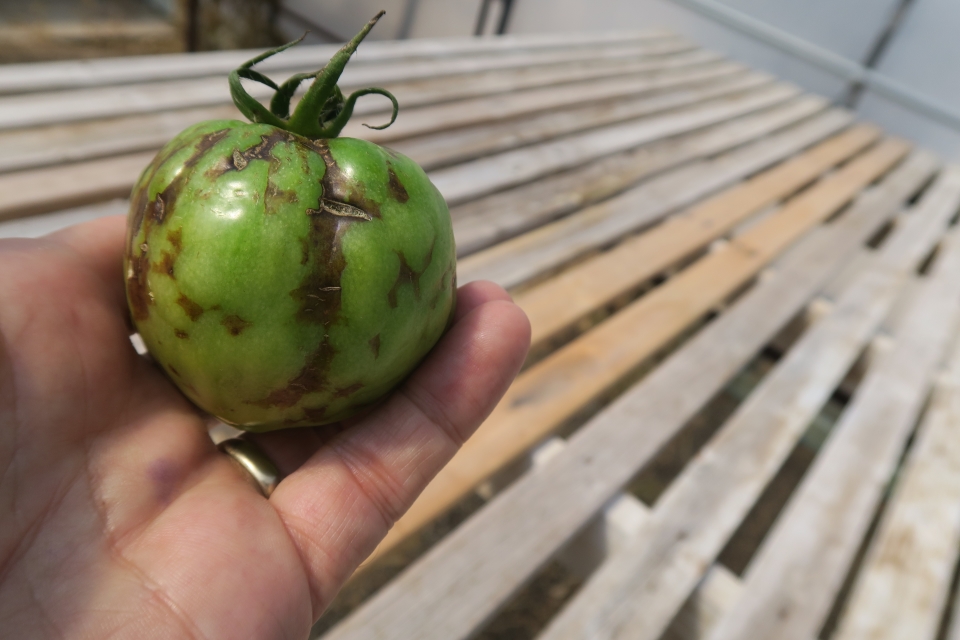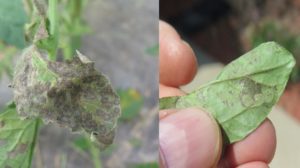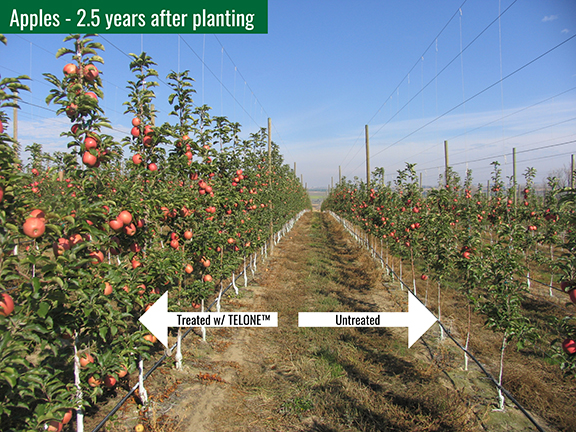Field Scouting Guide: How To Identify Tomato Spotted Wilt Virus

Tomato infected with tomato spotted wilt virus. Photo by Daniel Egel
This month’s guide concentrates on tomato spotted wilt Orthotospovirus (tomato spotted wilt virus or TSWV). We’ve reached out to pathologists to learn how to spot and treat this disease. This month, our contributors are Margaret Tuttle McGrath, Ph.D., Cornell University; Shouan Zhang, Ph.D., University of Florida/IFAS; Steven T. Koike, TriCal Diagnostics; Daniel S. Egel, Purdue University; and Anthony P. (Tony) Keinath, Clemson University.
Basics
- Scientific name: tomato spotted wilt Orthotospovirus (TSWV); tomato chlorotic spot Orthotospovirus (TCSV)
- Common name: Tomato spotted wilt virus (TSWV)
Most pathologists agree that TSWV is the scientific name as well as the common name, McGrath and Zhang say. For viruses, scientific and common names are similar, in contrast with other pathogens that have a Latin name. - Geographical Range: Found worldwide
- Crops affected: TSWV has a host range of more than 1,000 plant species in more than 85 families. Many vegetable and ornamental crops are impacted, including tomato, pepper, lettuce, potato, bean, pea, and basil.
Pest Impact
McGrath and Zhang: These viruses are much more serious problems in the Southeast U.S. (especially South Florida) than in the Northeast. It doesn’t become cold enough to kill plants and thrips, so TSWV, TCSV, and its vectors (thrips) survive year-round. TCSV became the most prevalent virus in tomatoes in Miami-Dade County.
Both viruses can kill plants when infection occurs early. Plants are susceptible from emergence. Infection occurring late in plant development can impact yield, by both reducing the quantity of fruit produced and because symptoms render fruit unmarketable. In the North, seedlings of tomato (as well as pepper and eggplant) have been infected while growing in a greenhouse with ornamentals harboring TSWV.
In fall 2014, roughly 30% to 40% of tomato plants in commercial production were infected with TCSV in Homestead, FL. In a field trial in Homestead the following spring, nearly 100% of tomato plants (var. FL 47, one of the most cultivated varieties in this area) were infected with TCSV about seven weeks after transplanting. The infected plants were severely stunted and did not develop fruit.
Koike: TSWV is a chronic problem on many crops (meaning it occurs every year), but severity varies. Some years it can be devastating; other years it is of minor concern. The economic impact can be significant, and the virus can be a problem any time. Plants infected early are the most severely affected. Fruiting vegetables (e.g., tomato and pepper) can have deformed fruit.
Egel: TSWV is a problem across the Midwest, primarily on tomatoes. In the northern Midwest, it’s a problem in greenhouses and high tunnels, while further south, TSWV can be a problem in the field, because thrips are a year-long problem.
Often, growers notice TSWV before first fruiting. Growers will contact me because the plants appeared stunted, yellow, and may have ring-spots. Later in the production season, growers may notice deformed fruit.
Keinath: TSWV is a perennial problem in South Carolina, and it is particularly severe in the southern half of the state. Before growers planted resistant varieties, I saw one field with 100% loss.
Identification

TSWV causes a ring pattern that can be confused with early blight, gray mold, or other fungal diseases. But the lesions caused by TSWV aren’t prominent on the underside of tomato leaves, while fungal pathogen lesions are easily observed on both sides of the leaves. Photo by Daniel Egel
Egel: TSWV causes a ring pattern that can be confused with early blight, gray mold, or other fungal diseases. But the lesions caused by TSWV aren’t prominent on the underside of tomato leaves, while fungal pathogen lesions are easily observed on both sides of the leaves.
The misshapen fruit caused by TSWV can be confused with herbicide injury.
You should understand how to scout for thrips, the vector for TSWV. Thrips cause a characteristic feeding pattern on tomato leaves.
When viewed with a 10X hand lens, you can see frass from the thrips near the feeding damage. When looking for thrips, it is sometimes helpful to search tomato blooms.
Koike: Identification is important. First, while experienced field personnel may have a good idea of what TSWV symptoms look like, it is still risky to identify any virus disease based only on symptoms. Testing is always a good idea since other virus symptoms may overlap with those of TSWV.
Second, TSWV symptoms are almost identical with those caused by the related Impatiens necrotic spot virus (INSV). INSV is widely found on vegetable and ornamental hosts. Both TSWV and INSV are vectored by thrips, so the diseases are difficult to manage because thrips control is challenging.
Keinath: The purpling of tomato leaves could be mistaken for phosphorus deficiency. Rolling and curling of tomato leaves could be mistaken for wilting or physiological leaf roll. The irregular ripening of tomato fruit could be mistaken for irregular ripening caused by whitefly feeding on plants.
Recommended Treatment
Egel: It is not possible to treat TSWV. Rather, one should treat for thrips, which are the vector of TSWV. It is important to select products registered for greenhouse use if the proposed treated area is in a greenhouse.
McGrath and Zhang: Tomato cultivars resistant to TSWV (SW5) are also resistant to TCSV in South Florida. We recommend using them as part of an IPM program for best success. Many tomato types available are not resistant to TSWV, including heirloom varieties.
To manage the diseases caused by both viruses in tomato:
- Select resistant or tolerant cultivars.
- Do not grow vegetables in the same greenhouse as ornamentals.
- Use virus-free transplants.
- Remove weeds growing around production fields. Purslane is a confirmed host for TCSV.
- Use UV-reflective mulch to repel thrips.
- Isolate susceptible crops using non-host barrier crops (such as sweet corn) to minimize virus transmission between fields.
- Intercrop with non-host, fast-growing crops to make habitat unappealing
to thrips. - Inspect crops for symptoms weekly and immediately rogue-affected plants to prevent viruses from spreading to healthy plants.
- Apply insecticides to reduce thrips populations and to limit secondary spread of the viruses.
- Apply systemic acquired resistance (SAR) elicitors (such as Actigard, Syngenta) to reduce symptom expression.
- Promptly destroy affected crop after last harvest.
- Rotate crop plantings.










